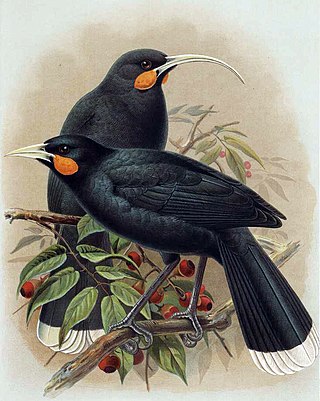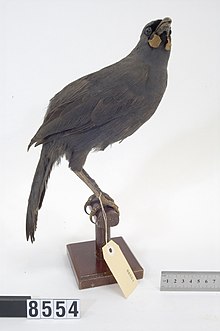
The morepork, also known by numerous other onomatopoeic names, is a smallish, brown owl species found in New Zealand, and to the northwest, on Norfolk Island, an Australian territory. It was also, formerly, found on Lord Howe Island. Three subspecies of the morepork are recognised, one of which is extinct and another that exists only as a hybrid population.

Callaeidae is a family of passerine birds endemic to New Zealand. It contains three genera, with five species in the family. One species, the huia, became extinct early in the 20th century, while the South Island kōkako is critically endangered and may be extinct.

The huia is an extinct species of New Zealand wattlebird, endemic to the North Island of New Zealand. The last confirmed sighting of a huia was in 1907, although there was another credible sighting in 1924.

The watercock is a waterbird in the rail and crake family, Rallidae that is widely distributed across Southeast Asia. It is the only member of the genus Gallicrex.

The Pacific black duck is a dabbling duck found in much of Indonesia, New Guinea, Australia, New Zealand, and many islands in the southwestern Pacific, reaching to the Caroline Islands in the north and French Polynesia in the east. It is usually called the grey duck in New Zealand, where it is also known by its Maori name, pārera.

Kōkako are two species of forest bird in the genus Callaeas which are endemic to New Zealand, the endangered North Island kōkako and the presumed extinct South Island kōkako. They are both slate-grey with wattles and have black masks. They belong to a family containing five species of New Zealand wattlebirds, the other three being two species of tieke (saddleback) and the extinct huia. Previously widespread, kōkako populations throughout New Zealand have been decimated by the predations of mammalian invasive species such as possums, stoats, cats and rats, and their range has contracted significantly. In the past this bird was called the New Zealand crow. It is not closely related to the crow, but looks like one from a distance.

The New Zealand kākā is a large species of parrot of the family Nestoridae found in New Zealand's native forests. The species is often known by the abbreviated name kākā, although it shares this name with the recently extinct Norfolk kākā and Chatham kākā. Two subspecies of New Zealand kākā are recognised. It is endangered and has disappeared from much of its former range, though the re-introduction of North Island kākā at Zealandia in Wellington has led to an increasing population of the birds across the city.

The tūī is a boisterous medium-sized bird native to New Zealand. It is blue, green, and bronze coloured with a distinctive white throat tuft (poi). It is an endemic passerine bird of New Zealand, and the only species in the genus Prosthemadera. It is one of the largest species in the diverse Australasian honeyeater family Meliphagidae, and one of two living species of that family found in New Zealand, the other being the New Zealand bellbird. The tūī has a wide distribution in the archipelago, ranging from the subtropical Kermadec Islands to the sub-Antarctic Auckland Islands, as well as the main islands.

The yellowhead or mohua is a small insectivorous passerine bird endemic to the South Island of New Zealand. Once a common forest bird, its numbers declined drastically after the introduction of rats and stoats, and it is now near threatened.

The saddlebacks or tīeke (Māori) are two species of New Zealand birds of the family Callaeidae. Both are glossy black with a chestnut saddle. Their taxonomic family is also known as that of the "wattlebirds" and includes the two species of kōkako, and the extinct huia. All members of the family Callaeidae have coloured fleshy wattles on either side of the beak; the saddlebacks' are a vivid red.

The New Zealand plover is a species of shorebird found only in certain areas of New Zealand. It is also called the New Zealand dotterel or red-breasted dotterel, and its Māori names include tūturiwhatu, pukunui, and kūkuruatu.

The common diving petrel , also known as the smaller diving petrel or simply the diving petrel, is a diving petrel, one of four very similar auk-like small petrels of the southern oceans. It is native to South Atlantic islands and islands of the subantarctic southern Indian Ocean, islands and islets off New Zealand and south-eastern Australian islands.

The red-capped lark is a small passerine bird that breeds in the highlands of eastern Africa southwards from Ethiopia and Somaliland. In the south, its range stretches across the continent to Angola and south to the Cape in South Africa.

The New Zealand pipit is a fairly small passerine bird of open country in New Zealand and outlying islands. It belongs to the pipit genus Anthus in the family Motacillidae.

The grey petrel, also called the brown petrel, pediunker or grey shearwater is a species of seabird in the Procellariidae, or petrel family. It is pelagic and occurs in the open seas of the Southern Hemisphere, mainly between 32°S and 58°S.

The black-faced ibis is a species of bird in the family Threskiornithidae. It is found in grassland and fields in southern and western South America. It has been included as a subspecies of the similar buff-necked ibis, but today all major authorities accept the split. The black-faced ibis also includes the Andean ibis as a subspecies. Some taxonomic authorities still do so.

The spotless crake is a species of bird in the rail family, Rallidae. It is widely distributed species occurring from the Philippines, New Guinea and Australia, across the southern Pacific Ocean to the Marquesas Islands and south to New Zealand.

The North Island kōkako is an endangered forest bird which is endemic to the North Island of New Zealand. It is grey in colour, with a small black mask. It has blue wattles. Because of its wattle, the bird is sometimes locally called the blue-wattled crow, although it is not a corvid.

The South Island saddleback or tīeke is a forest bird in the New Zealand wattlebird family which is endemic to the South Island of New Zealand. Both the North Island saddleback and this species were formerly considered conspecific. The Department of Conservation currently has the South Island saddleback listed as At Risk--Declining.






















